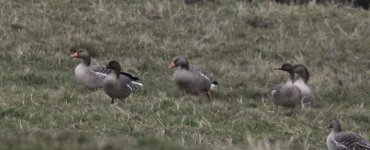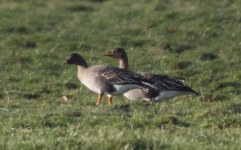-
Welcome to BirdForum, the internet's largest birding community with thousands of members from all over the world. The forums are dedicated to wild birds, birding, binoculars and equipment and all that goes with it.
Please register for an account to take part in the discussions in the forum, post your pictures in the gallery and more.
You are using an out of date browser. It may not display this or other websites correctly.
You should upgrade or use an alternative browser.
You should upgrade or use an alternative browser.
Bean Geese but which race? (1 Viewer)
- Thread starter 93Birder
- Start date
More options
Who Replied?The bill size and patten suggest Tiga for the right hand bean goose. The other apears smaller and more pink foot like , which points to tundra , but that bill looks rather deep for a tundra. I do not think its possible to be sure without a clearer photo or a run oif photos.
93Birder
Well-known member
The bill size and patten suggest Tiga for the right hand bean goose. The other apears smaller and more pink foot like , which points to tundra , but that bill looks rather deep for a tundra. I do not think its possible to be sure without a clearer photo or a run oif photos.
Thanks, the fact you think one is taiga is great. That's the one which I was worried about!
birdboybowley
Well-known member.....apparently so ;)

Gotta admit the right-hand bird does look taiga-ish. Arse, had a phonecall from a mate today watching these distantly but was told they were both Tundra......shoulda popped down and had a look after all.....how far along the Arun were they when you saw them?
Brian Stretch
Well-known member
It's not just the bill of the right hand bird that make it look like a Taiga.
The difference in the head structure is also very noticeable. The left hand Bean (Tundra) has a typical compact Pinkfoot-like head while the right hand Bean has the a sleeker swan-like head.
Of course, we're relying on one picture which may be misleading in trying to truly assess the structure of these birds. Are there any more pics available?
Brian
The difference in the head structure is also very noticeable. The left hand Bean (Tundra) has a typical compact Pinkfoot-like head while the right hand Bean has the a sleeker swan-like head.
Of course, we're relying on one picture which may be misleading in trying to truly assess the structure of these birds. Are there any more pics available?
Brian
birdboybowley
Well-known member.....apparently so ;)

Here's a link to another photo.....both looking more Tundra-like now......fun fun fun 
https://www.facebook.com/WWTArundel...27421361.68000.218806804806317&type=1&theater
https://www.facebook.com/WWTArundel...27421361.68000.218806804806317&type=1&theater
lewis20126
Well-known member
In any flock of Tundra Beans, I would expect to get a few "orange-billed" birds. We had one in a flock of 9 Tundras at Keyhaven a few winters ago. To get one in a flock of two is statistically less likely of course.
cheers, alan
cheers, alan
In any flock of Tundra Beans, I would expect to get a few "orange-billed" birds. We had one in a flock of 9 Tundras at Keyhaven a few winters ago. To get one in a flock of two is statistically less likely of course.
cheers, alan
But to get one in a flock of two that has people confused over the racial ID does not seem unlikely at all
However, I am not 100% sure these are rossicus. The right hand bird in the first picture seems quite fabalis-like (but admittedly less so in the second picture), while the left hand bird has more of a rossicus-feel to it (again, less so in the second picture).
Lutzen
birdboybowley
Well-known member.....apparently so ;)

Ok, finally got round to getting some grabs off the short bit of vid I took the other Friday of these birds. They have been 'dismissed' as Tundras but I can't help having a nagging doubt. Now, I don't see alot of Bean Geese so really am looking to be educated as to why they're both Tundras. The 'darker-billed' bird is what I'd call a classic-looking Tundra but when seen together, the other 'orange-billed' goose is certainly bigger (in pic 5 it is actually behind the other goose and still looms larger - can there really be that much difference between the sexes of Tundra??). It seems to have a larger bill, although this couls indeed be due to the larger orange patch giving it that impression, but it's certainly larger (not that much smaller than the Greylags) and has definitely more distinct white edging to the back/wing feathers and a paler base of the neck.....
If they are both Tundras then that's fine too, I just like to be sure and hopefully someone alot more 'goosey' than me can help put my mind to rest. Apologise for the quality of the grabs...hand held to scope, cold, etc etc
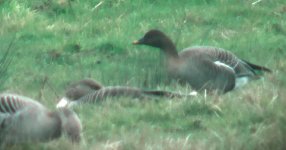
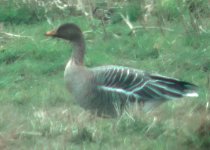
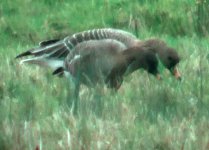
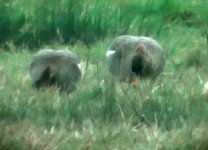
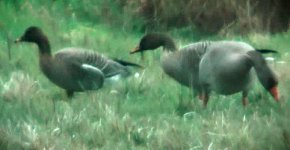
TIA, look forward to hearing people's views
If they are both Tundras then that's fine too, I just like to be sure and hopefully someone alot more 'goosey' than me can help put my mind to rest. Apologise for the quality of the grabs...hand held to scope, cold, etc etc





TIA, look forward to hearing people's views
birdboybowley
Well-known member.....apparently so ;)

Bump.....
birdboybowley
Well-known member.....apparently so ;)

No-one, really???? Come on guys, give it a punt!
Jan-Paul Charteris
Sussex birder and budding moth enthusiast
No-one, really???? Come on guys, give it a punt!
My first reaction on seeing Jake's photo on the Facebook page was one Tundra and one Taiga, even before I'd seen there'd been any discussion on them. My opinion on seeing your video grabs remains the same. I've never seen the two side by side though, and haven't got masses of experience with either. If I'd seen the larger one on it's own though, I'd have considered (perhaps wrongly, who knows!) that it was a fabalis based on the seemingly longer neck (though maybe not proportionately so), head profile, longer bill (?), more orange on bill, and size compared to Greylags (though the other plumage differences like the overall plumage shade and the barring above seem pretty obvious too, no idea if they are characters of fabalis)
Then again, I'm sure I've seen photos where the size and jizz difference didn't seem as marked between the two birds, at least from a cursory glance.
Be interesting to hear from others with more experience of both 'races'. I didn't go to see them because after some initial discussion, apparently it'd been confirmed both were Tundra (which I've seen quite a few more of!)
Last edited:
I have not changed my mind from the original photo. In pic 3 they look very much as examples of both races. The size difference bill size and pattern of the larger look very Forest bean like to me. However I have a nagging doubt that the size and plumage variation could be due to an adult and 1st winter bird.
Jan-Paul Charteris
Sussex birder and budding moth enthusiast
I have not changed my mind from the original photo. In pic 3 they look very much as examples of both races. The size difference bill size and pattern of the larger look very Forest bean like to me. However I have a nagging doubt that the size and plumage variation could be due to an adult and 1st winter bird.
My biggest doubt is over the link in post 7, in which both birds look so similar in size and jizz. Obviously optical size illusion can make a bird further from the camera look comparatively larger than one closer to the camera, and it's not always easy to determine the relative distance from camera with grassland feeding birds.
Also one thing that has always struck me when watching Taiga (fabalis) in life, is the proportionately long neck. I find in flight or on the deck, it adds to the almost swan like appearance partly created by the head/bill profile. In very few of these photos (and none of the video grabs) does it look proportionately longer necked than the other bird. In the photos in which it does, like the one in the opening post, it's probably just because one is alert and the other isn't
I do think they may be one of each, most photos seem to show a genuine difference in head shape. Really not sure though!
Last edited:
Jan-Paul Charteris
Sussex birder and budding moth enthusiast
This link may be of interest. Scroll down to what seems to be a pair of Tundra rossicus showing significant size difference and apparent difference in head/bill size and profile, the conclusion Martin makes in the link is that this difference could be sex related. Tideliner's suggestion that the plumage and size difference may also be age related could be a good point, though I've never tried to age Bean Geese in the field so I'm not sure
O' for the happy days when a bean goose in the UK was just a bean goose. Just to through a spanner in the works are we sure these birds are wild ? The WWT has a big collection of waterfowl in the area and escapes are not unknown and they have held several races in their collections.
Last edited:
Jan-Paul Charteris
Sussex birder and budding moth enthusiast
O' for the happy days when a bean goose in the UK was just a bean goose. Just to through a spanner in the works are we sure these birds are wild ? The WWT has a big collection of waterfowl in the area and escapes are not unknown and they have held several races in their collections.
Yep, but then again Bean Goose used to be considered conspecific with Pink-footed Goose, so it's lucky some things have changed
The WWT centre at Arundel doesn't have any Bean Geese at all luckily, so if they did escape then it wasn't from there!
Can't remember if it was on here, but there was some ID discussion recently over a couple of Greylags in the same flock which showed intermediate features between Western and Eastern Greylag too
birdboybowley
Well-known member.....apparently so ;)

Cheers for the extra input guys. It seems that Bean Geese are fraught with difficulty! Could well be both Tundra, but would be surprised if age differed them so dramatically, esp as the 'younger' bird is a classic Tundra.
It was just the fact that they had been put down as Tundra with no reasoning behind it by some of the more, er 'infamous' birders around, when the bigger bird is obviously anything but a classic Tundra.
It was just the fact that they had been put down as Tundra with no reasoning behind it by some of the more, er 'infamous' birders around, when the bigger bird is obviously anything but a classic Tundra.
Users who are viewing this thread
Total: 2 (members: 0, guests: 2)




